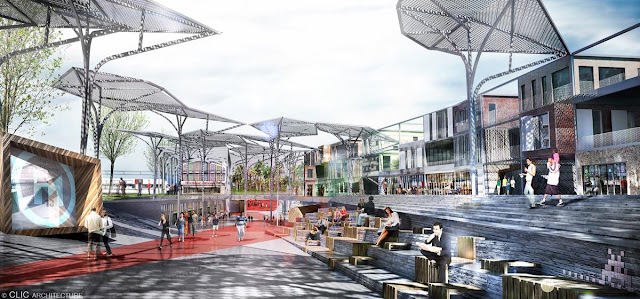Effets de Serres . Europan 11 . Stains
CLIC Architecture . + archdaily
One cannot consider sustainability without mentioning energy issues.
The changes ahead have a major effect on the world economy, the environment, and society at large; They beg for creative new ways of life. Although our proposal first uses the concept of greenhouses as an energetic solution, it then leans on its high flexibility and economic capacities to create an evolutionary design.
Our project for Stains composes with existing uses and paths as it integrates the essential dimension of time, combining mobility time within the everyday urban timeline. We feel this is crucial, as this suburban territory and its inhabitants’ quality of life have been neglected for the benefit of its capital city for too many years.
The new Batetes area highlights existing bioproductive uses by blending in the paths and allotments structure. The greenhouses are a spatial matrix used in designs ranging from public space definition to private planted rooftops and therefore maximize the potential uses of such spaces (cultivation, playground areas, indoor public squares or patios).
It really is about maximizing one’s housing self-appropriation possibilities, and allowing the “second works” concept to happen. We feel it is time to reconnect the rushing urban and mobility beats to more earthy slower rhythms, as it definitely is a key-notion to new sustainable cities.
Team: Adèle Catherine, Aurélie Francois, Laura Giuliani, Emmnanuelle Klinger, Pierre-Emmanuel Limondin
Status: 1st place
CLIC Architecture . + archdaily
One cannot consider sustainability without mentioning energy issues.
The changes ahead have a major effect on the world economy, the environment, and society at large; They beg for creative new ways of life. Although our proposal first uses the concept of greenhouses as an energetic solution, it then leans on its high flexibility and economic capacities to create an evolutionary design.
Our project for Stains composes with existing uses and paths as it integrates the essential dimension of time, combining mobility time within the everyday urban timeline. We feel this is crucial, as this suburban territory and its inhabitants’ quality of life have been neglected for the benefit of its capital city for too many years.
The new Batetes area highlights existing bioproductive uses by blending in the paths and allotments structure. The greenhouses are a spatial matrix used in designs ranging from public space definition to private planted rooftops and therefore maximize the potential uses of such spaces (cultivation, playground areas, indoor public squares or patios).
It really is about maximizing one’s housing self-appropriation possibilities, and allowing the “second works” concept to happen. We feel it is time to reconnect the rushing urban and mobility beats to more earthy slower rhythms, as it definitely is a key-notion to new sustainable cities.
Team: Adèle Catherine, Aurélie Francois, Laura Giuliani, Emmnanuelle Klinger, Pierre-Emmanuel Limondin
Status: 1st place


.jpg)
.jpg)
.jpg)
.jpg)
.jpg)
.jpg)
.jpg)
.jpg)
.jpg)





.jpg)











.jpg)
.jpg)
.jpg)

.jpg)
.jpg)
.jpg)

.jpg)
.jpg)


0 comentarios :
Publicar un comentario